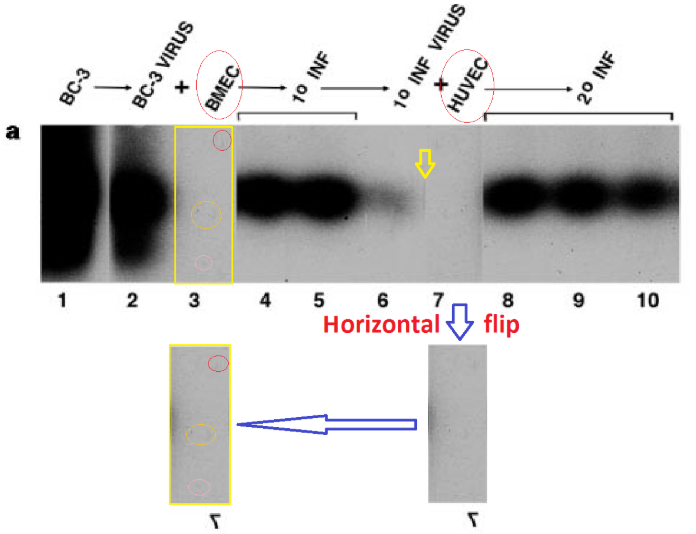
Nature has issued an editorial expression of concern on a paper published 27 years ago — and nearly nine years after learning of an “irregularity” in a figure.
According to the June 18 statement, a figure in the 1998 paper showed duplicated control lanes, with one of them flipped.
Pseudonymous sleuth Claire Francis flagged the issue on PubPeer in 2016, and reported the problem to the journal at the same time, Francis told Retraction Watch.
The 1998 paper has been cited 333 times, according to Clarivate’s Web of Science, 32 of which were after 2016 when the image issue was first flagged.
Corresponding author Ethel Cesarman, a professor at Weill Cornell Medicine, told us she learned of the issue with the figure from the comment on PubPeer, although she did not learn about it until 2018, “when a ‘Claire Francis’ contacted my institution and collaborators, who then reached out to me.”
“We have procedures to assess the claims and for the institution to conduct an investigation, which in this case found an issue related to the use of cropped gels leading to an inadvertent image duplication on negative control lanes,” Cesarman told us. She said she contacted the journal about the paper after the conclusion of the investigation in 2021. “After reviewing the institution’s report, the journal makes their own decision regarding informing their readers.”
A spokesperson for Weill Cornell Medicine confirmed the institute investigated the paper, and that the wording of the notice “reflects the findings of our evaluation through institutional processes.”
All the authors except one, for whom the journal could not obtain current contact information, agreed with the journal’s decision.
A spokesperson for Nature did not address our question about when they first heard about the problem with the figure.
“Given the age of the article and the fact that the authors no longer have the original raw data for the figure, we determined in consultation with the Springer Nature Research Integrity Group that issuing an Editorial Expression of Concern (EEoC) was the most appropriate course of action,” the spokesperson said. “This allows us to alert readers to interpret the results with caution while acknowledging that the concern could not be fully resolved.”
Cesarman has one previous retraction with different coauthors. Published in the Journal of Experimental Medicine, the 2004 paper earned a correction in 2006 and was retracted in 2021 ”due to multiple instances of splicing and the image manipulation to remove background gel artifacts” following an investigation by Weill Cornell Medicine, according to the retraction notice. Including this retraction and a correction, Cesarman has 14 papers with comments on PubPeer.
Like Retraction Watch? You can make a tax-deductible contribution to support our work, follow us on X or Bluesky, like us on Facebook, follow us on LinkedIn, add us to your RSS reader, or subscribe to our daily digest. If you find a retraction that’s not in our database, you can let us know here. For comments or feedback, email us at [email protected].
25 year old Nature paper not without problematic data.
https://pubpeer.com/publications/31695E23BA9C15556E5D6B8CEA931B
First author on the 1998 Nature paper is last author on this one: https://pubpeer.com/publications/9B602AB4964935952174A30BDF26DE
It’s amazing how researchers routinely face zero career consequences for what is at best sloppy research which wastes everyone’s time and tax payers money or at worst active attempts to fake data and results.
It’s all about the money and saving face. (To profit-driven journals and research institutions, at least.) Peer review no longer feels like a sufficient safeguard in today’s system.
1999 Nature paper. How to explain the data?
https://pubpeer.com/publications/3620BA59CC17B5DB62215DD774D352
Will reward? Will fudge. End of story. Bye 👋
Can anybody some up with a logical explanation for this 2006 Blood paper?
https://pubpeer.com/publications/2CF0AD15767F7E22A39DEDC78E40D0
I am always surprised by this 2001 Cell/Nature cross-over event. The cross-over event is in comment #2. You might think that Nature would take up the cudgels against Cell, but it sits on its hands. Big publishers together.
https://pubpeer.com/publications/65ECC6CE97FC8FD6C8139C293F6064
I think that this Expression of Concern will come to be seen by Nature as a tactical mistake. It is better never to waver, “admit to nothing” as the best strategy, for fear of what else may come to light. This strategy has worked very well until now. “Stood the test of time” as they say about “old”, more than a few years old, papers containing problematic data. The formation of sedimentary rock before our eyes.
They say that love is blind, but Nature was blind for years until somebody pointed it out, and there may still be problems.
https://pubpeer.com/publications/D4EB54486961BB838E92A62426926B